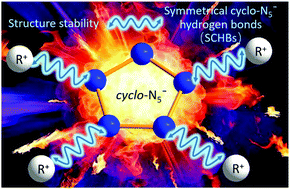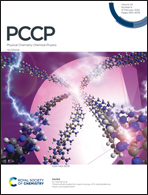Symmetrical cyclo-N5− hydrogen bonds: stabilization mechanism of four non-metallic cyclo-pentazolate energetic salts†
Abstract
Pairing different cations (R+) to stabilize cyclo-N5− is the main synthesis path for non-metallic cyclo-pentazolate (cyclo-N5−) salts. As novel energetic materials (EMs), crystalline packing-force of cyclo-N5− salts has been a puzzle, and whether cyclo-N5− is protonated also is a controversial issue. In this paper, four non-metallic cyclo-N5− salts, PHAC, N2H5N5, NH3OHN5, and NH4N5, are quantitatively studied by coupling first-principle method and bond-strength analyzing technology. Different from the traditional CHON-EMs (molecular crystal) and azide-EMs (ionic crystal), the four salts are stabilized by 3D hydrogen bond (HB) networks. One new type of hydrogen bond, protonated HB (p-H, R–H⋯N5−), is discovered to be a key stabilizing factor for cyclo-N5−. Proton competition mechanism between R and cyclo-N5− in p-H HB showed that cyclo-N5− cannot be protonated into HN5. In general, p-H HB can be adopted to estimate the stability of novel non-metallic cyclo-N5− EMs. Such findings have great significance for future design and performance prediction of novel cyclo-N5− EMs in both theoretical and experimental aspects.



 Please wait while we load your content...
Please wait while we load your content...